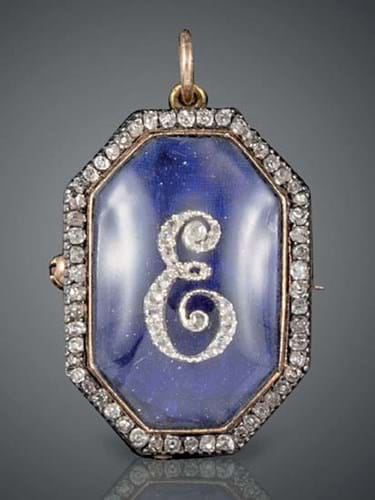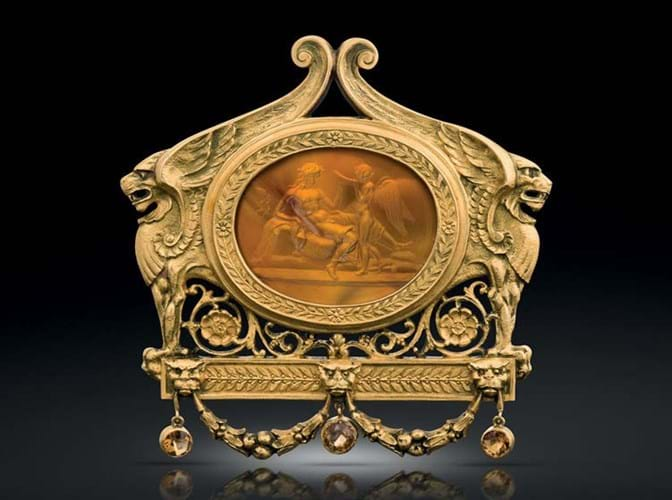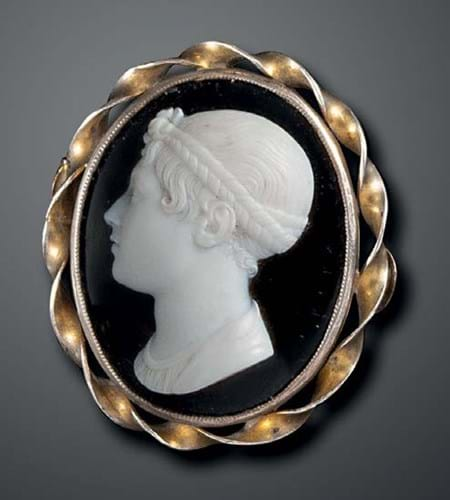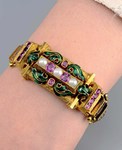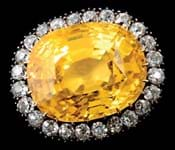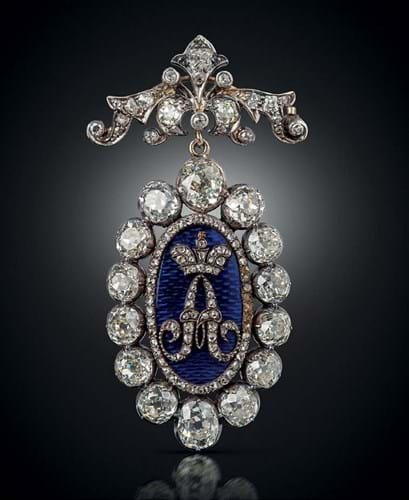
The £2.1m ‘post-lockdown’ sale at Woolley & Wallis (25% buyer’s premium) in Salisbury on July 15 had all three and in rare quantity.
Antique pieces dominated. An early 19th century diamond and blue enamel monogram brooch had come by descent to its owner from John Delaware Lewis (1774-1841), an American merchant who operated in St Petersburg for 30 years. Family tradition holds that the brooch was given to him as a gift by Maria Feodorovna (1758-1828), second wife of Tsar Paul I.
The diamond-set A monogram probably refers to Alexander I, tsar from 1801-25: a similar monogrammed ring in the Hermitage Museum was acquired from the collection of Grand Duke Alexei Alexandrovich (1850-1908). Estimated at £6000-8000, it sold to an international private collector for £22,000.
A George III diamond and enamel monogram brooch set with the letter E in a closed-back silver and gold mount with detachable fittings sold in a Harvey & Gore case for £5500 (estimate £600- 800) to the international trade. It was part of a privately consigned collection of 31 lots.
From the same period was a pair of late George III diamond drop earrings set with clusters and demi-hoops of cushion-shaped stones. These took £27,000 against a similarly accessible guide of £6000-8000.

Early 20th century diamond-set elephant brooch by Cartier with a Hindi inscription for the 1911 Delhi Durbar (see detail) – £10,000 at Woolley & Wallis.
Estimated at £1500-2000, an early 20th century diamond-set elephant brooch by Cartier generated plenty of interest. As well as a signature, the number 1218 and French control marks, it was engraved verso with a Hindi inscription for the Delhi Durbar, 1911. This massive assembly organised at Coronation Park, Delhi, one of three held in 1877, 1903, and 1911, at the height of the British Empire, was the only one that a sovereign, George V, attended. It sold to a UK private collector for £10,000.
The cover lot to the sale was an Art Nouveau enamel butterfly bracelet by Carreras which sold at the lower end of a £50,000-70,000 estimate.
When made c.1905 this represented a huge change of direction for the Barcelona firm hitherto known as the go-to atelier for traditional Iberian jewels. This is perhaps the firm’s best-known creation in the style referred to in Catalonia as Modernisme – designed as a series of four yellow gold panels, each decorated with a butterfly in plique-à-jour and cloisonné polychrome enamel.
It is signed with applied gold plaque to the reverse E de A. Carreras Barcelona and came in a fitted case marked Antigua Joyeria Carreras Paseo Gracia 30 calle Fernando 44 Bakcalona. The buyer was a UK private collector.
First-timers
Woolley & Wallis jewellery specialist Marielle Whiting said the sale included a significant increase in online bidding (up 70% from the equivalent sale in January).
“This spike included regular buyers driven online by circumstances, but we have also seen a high number of private clients engaging with our auctions for the first time while working from home,” she said.
“Private buyers, armed with disposable income as holidays and social occasions are cancelled, are pushing up prices, but it’s reassuring for our vendors that the market has not been adversely affected by coronavirus.”
Sold at £12,000 was an extraordinary early 20th century gold neoclassical pendant by Andre Bucher. Housed in a 3in (7.5cm) gold frame of stylised Babylonian griffins and grotesque masks is a cornelian intaglio depicting a youthful Cupid drinking wine from a bowl held by a reclining Bacchus.
This allegory of the effect of wine on love is a faithful copy of a marble relief by the Danish sculptor Bertel Thorvaldsen (1770-1844) and probably cut by Luigi Pichler (1773-1854). Pichler, a member of the celebrated family of German- Italian gem engravers, spent much of his career in Vienna – becoming professor of gem engraving at Akademie der Bildenden Künste, a post he held until 1850 before retiring to Rome.
It went to an international collector bidding via the phone manned by the firm’s Chinese paintings specialist Freya Yuan-Richards.
Cameos and intaglios
More than 30 cameos and intaglios featured in the sale, a number of them sparking interest from bidders in the Far East.
Sold to the UK trade for £4000, double the top estimate, was an early 19th century sardonyx cameo depicting Emma, Lady Hamilton in profile with her hair in the Grecian style. It was mounted as a brooch in a silver-gilt rope-twist frame.
This cameo was signed Rega for Filippo Rega (1761-1833) an Italian engraver and medallist who was a student of Giovanni Pichler (1734-91) in Rome before moving to Naples in 1787. It was possibly taken from life rather than an engraving as Emma Hamilton also lived in Naples at the time, having been sent there to marry Sir William Hamilton in 1786. Rega also produced a glass portrait intaglio of her that is in the National Maritime Museum.
Whiting noted that – at a time when the gold price has spiked – the market for good coloured stones was also strong.
Top lots
Two ‘fancy’ yellow diamonds provided the top lots of the sale. Sold just under hopes at £75,000 was a ring with a central cushion-shaped ‘fancy vivid yellow’ stone weighing 5.26cts, while £65,000 was bid for an early 20th century diamond pendant centred fancy-coloured old cushion-shaped diamond weighing 11.65cts.
The latter, in a case by Hamiltons of Calcutta, was previously owned by the Nawab Sultan Jahan Begum (1858-1930) and had been given as a gift to Agnes Elizabeth Anna Mathew (nee Woodroffe), whose husband helped establish the modern judicial system in India.
“The prices reflect their quality and rarity, but they are also viewed as investments,” said Whiting. “Whenever there is any economic uncertainty the price of jewellery tends to escalate as buyers turn to what they view as a traditional safe haven. I think we can see that reflected in the results of this sale.”


